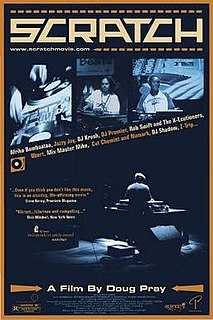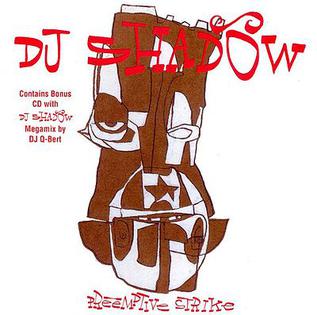Related Research Articles

A disc jockey, more commonly abbreviated as DJ, is a person who plays recorded music for an audience. Types of DJs include radio DJs, club DJs, mobile DJs, and turntablists. Originally, the "disc" in "disc jockey" referred to shellac and later vinyl records, but nowadays DJ is used as an all-encompassing term to also describe persons who mix music from other recording media such as cassettes, CDs or digital audio files on a CDJ, controller, or even a laptop. DJs may adopt the title "DJ" in front of their real names, adopted pseudonyms, or stage names.

Scratching, sometimes referred to as scrubbing, is a DJ and turntablist technique of moving a vinyl record back and forth on a turntable to produce percussive or rhythmic sounds. A crossfader on a DJ mixer may be used to fade between two records simultaneously.
A battle record, also often called a battle tool or battle breaks, is a vinyl record made up of brief samples from songs, film dialogue, sound effects, and drum loops for use by a DJ. The samples and drum loops are used for scratching and performances by turntablists. The most famous example of this format is Super Duck Breaks, a 1996 release by "The Turntablist," a pseudonym of DJ Babu.

Turntablism is the art of manipulating sounds and creating new music, sound effects, mixes and other creative sounds and beats, typically by using two or more turntables and a cross fader-equipped DJ mixer. The mixer is plugged into a PA system for live events and/or broadcasting equipment so that a wider audience can hear the turntablist's music. Turntablists manipulate records on a turntable by moving the record with their hand to cue the stylus to exact points on a record, and by touching or moving the platter or record to stop, slow down, speed up or, spin the record backwards, or moving the turntable platter back and forth, all while using a DJ mixer's crossfader control and the mixer's gain and equalization controls to adjust the sound and level of each turntable. Turntablists typically use two or more turntables and headphones to cue up desired start points on different records.

Richard Quitevis known by his stage name DJ Qbert or Qbert, is an American turntablist and composer. He was awarded America's Best DJ in 2010, was DMC USA Champion 1991 (solo) and achieved titles as DMC World Champion in 1992 and 1993.

Scratch is a 2001 documentary film, directed and edited by Doug Pray. The film explores the world of the hip-hop DJ from the birth of hip-hop when pioneering DJs began extending breaks on records, to the invention of scratching and beat juggling, to the more recent explosion of turntablism. Throughout the documentary, many artists explain how they were introduced to hip-hop while providing stories of their personal experiences.
The Invisibl Skratch Piklz are an American group of turntablists.

Preemptive Strike is the first compilation album by American hip hop producer DJ Shadow, released by Mo' Wax on January 27, 1998. It contains DJ Shadow's singles released by Mo' Wax between 1993 and 1997. It peaked at number 118 on the Billboard 200 chart.
Simon Lewicki, also known as Groove Terminator and GT, is an Australian electronic music artist.

Michael Schwartz, better known by his stage name Mix Master Mike, is an American turntablist best known for his work with Beastie Boys.

A DJ mixer is a type of audio mixing console used by disc jockeys (DJs) to control and manipulate multiple audio signals. Some DJs use the mixer to make seamless transitions from one song to another when they are playing records at a dance club. Hip hop DJs and turntablists use the DJ mixer to play record players like a musical instrument and create new sounds. DJs in the disco, house music, electronic dance music and other dance-oriented genres use the mixer to make smooth transitions between different sound recordings as they are playing. The sources are typically record turntables, compact cassettes, CDJs, or DJ software on a laptop. DJ mixers allow the DJ to use headphones to preview the next song before playing it to the audience. Most low- to mid-priced DJ mixers can only accommodate two turntables or CD players, but some mixers can accommodate up to four turntables or CD players. DJs and turntablists in hip hop music and nu metal use DJ mixers to create beats, loops and so-called scratching sound effects.

Alain Macklovitch, known by his stage name A-Trak, is a Canadian DJ, record producer, and record executive. He came to prominence in the late 2000s as an international club DJ and remix artist, known for incorporating highly technical turntable skills and scratching into his genre-spanning work. He is also President of the record label Fool's Gold, which was founded in 2007 and is credited for developing the careers of artists such as Kid Cudi, Danny Brown, and Flosstradamus. Among other collaborative projects, he is part of the DJ duo Duck Sauce with Armand Van Helden and was nominated for a Grammy in 2012 for their song "Barbra Streisand".

DJ Rectangle is an American DJ/turntablist and Grammy Award-nominated Dance/Hip Hop/Club record producer.
DJ Disk is a turntablist from the San Francisco Bay Area. He is of Panamanian, Colombian, and Nicaraguan descent. Born Luis Quintanilla on October 7, 1970, in San Francisco, Disk began scratching and mixing vinyl at a young age. In 1992, he joined his long-time friend DJ Qbert among the Rock Steady Crew DJs, later changing the group's name to the Invisibl Skratch Piklz.
DJ Woody is a prolific DJ and turntablist born in Burnley, Lancashire UK.
Turntablist Transcription Methodology, or TTM, is a notation system for scratching and turntablism written & published by John Carluccio formatted by Ethan Imboden, and designed as well as transcribed by Raymond Pirtle aka DJ Raedawn. It is an intuitive graphical representation of the movement of a record whilst performing with a turntable, and was originally documented in a booklet form for distribution used by turntablists around the world.

Anthony Williams, better known as Roc Raida or Grandmaster Roc Raida, was an American DJ, turntablist and producer. He was also a member of the DJ group the X-Ecutioners.
Mr. Dibbs is an American DJ and hip hop producer. He is the Founder of 1200 HOBOS [dj/graff collective]. He was also one of the founders of Scribble Jam.
Return of the DJ, Vol. 1 is a 1995 compilation released by Bomb Hip-Hop Records. This project was the first all dj/all scratching (turntablist) album ever released. It has been re-released in 1997 with new album artwork, Return of the DJ, Vol. 1 compilation and a collection of beats for DJ's. Return of the DJ is known as the first all-DJ album, helping to start the careers of turntablists such as DJ Q-bert, Cut Chemist, DJ Z-Trip, and others.
Dave Cuasito, better known by his stage name D-Styles, is a hip hop producer and DJ. He has been a member of Invisibl Skratch Piklz, Beat Junkies, and Third Sight. He has also been a resident DJ of Low End Theory. D-styles is an instructor at the Beat Junkies Institute of Sound.
References
- ↑ Webber, S.W. (2008). DJ Skills: The Essential Guide to Mixing and Scratching. Focal. p. 269. ISBN 978-0-240-52069-8 . Retrieved 14 May 2019.
- ↑ SPIN. SPIN Media LLC. p. 128. Retrieved 14 May 2019.
- ↑ Archive-LVR-Odiaga (25 May 2000). "San Francisco To Host First Scratch DJ Conference". MTV News. Retrieved 14 May 2019.
- ↑ Partridge, E.; Dalzell, T.; Victor, T. (2008). The Concise New Partridge Dictionary of Slang and Unconventional English. Dictionary of Slang and Unconvetional English. Routledge. p. 256. ISBN 978-0-415-21259-5 . Retrieved 14 May 2019.
- ↑ Weigant, C. (2000). Careers as a Disc Jockey: Second Edition. The Career Resource Library. Rosen Publishing Group. p. 105. ISBN 978-0-8239-3043-2 . Retrieved 14 May 2019.
- ↑ Kouri, C.J.; Shure, R.L.; Blake, H.; Lee, J.; Active Graphics, Inc; Hayward Blake & Company; Poppi-Laudatio (Firm) (2001). Shure: sound people, products, and values. Shure: Sound People, Products, and Values. Shure Inc. ISBN 978-0-9710738-0-7 . Retrieved 14 May 2019.
- ↑ CMJ New Music Monthly. CMJ Network, Inc. p. 54. Retrieved 14 May 2019.